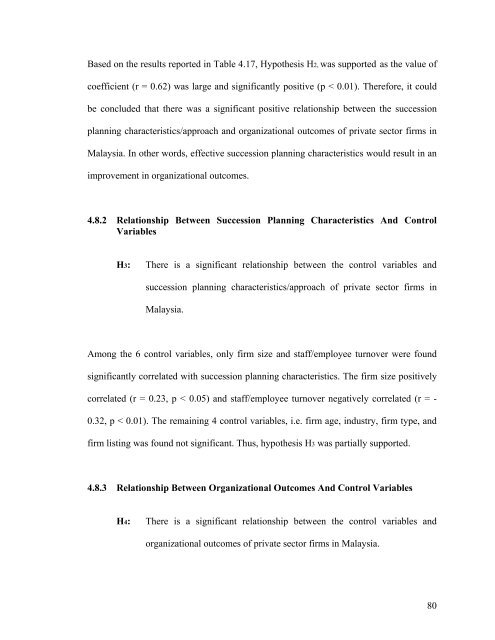CHAPTER 1: INTRODUCTION 1.0 Chapter Overview - DSpace@UM
CHAPTER 1: INTRODUCTION 1.0 Chapter Overview - DSpace@UM
CHAPTER 1: INTRODUCTION 1.0 Chapter Overview - DSpace@UM
You also want an ePaper? Increase the reach of your titles
YUMPU automatically turns print PDFs into web optimized ePapers that Google loves.
Based on the results reported in Table 4.17, Hypothesis H2, was supported as the value ofcoefficient (r = 0.62) was large and significantly positive (p < 0.01). Therefore, it couldbe concluded that there was a significant positive relationship between the successionplanning characteristics/approach and organizational outcomes of private sector firms inMalaysia. In other words, effective succession planning characteristics would result in animprovement in organizational outcomes.4.8.2 Relationship Between Succession Planning Characteristics And ControlVariablesH3: There is a significant relationship between the control variables andsuccession planning characteristics/approach of private sector firms inMalaysia.Among the 6 control variables, only firm size and staff/employee turnover were foundsignificantly correlated with succession planning characteristics. The firm size positivelycorrelated (r = 0.23, p < 0.05) and staff/employee turnover negatively correlated (r = -0.32, p < 0.01). The remaining 4 control variables, i.e. firm age, industry, firm type, andfirm listing was found not significant. Thus, hypothesis H3 was partially supported.4.8.3 Relationship Between Organizational Outcomes And Control VariablesH4: There is a significant relationship between the control variables andorganizational outcomes of private sector firms in Malaysia.80
















